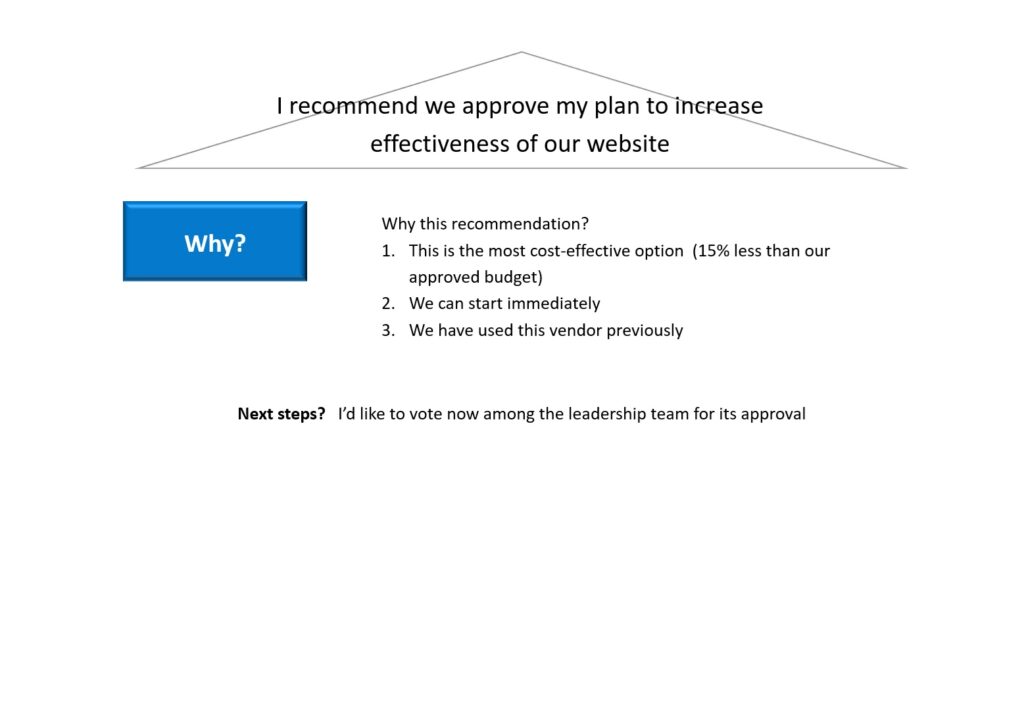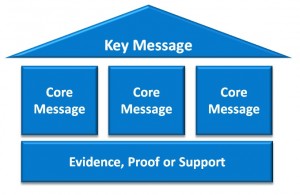The Message House
It’s one of the oldest rules in communications, simply known as The Rule of 3s.
In 1956, psychologist George Miller at Princeton University concluded from research that individuals normally retain only seven serial-order items of information (give or take two items) in their short-term memory. The theory became known as 7+2, also ‘Miller’s Magic Number,’ and eventually ‘Miller’s Law.’
(The same George Miller developed another key rule of communications, also known as Miller’s Law, relating to listening. As far as I know this George Miller is not related the Australian film director George Miller.)
Since that time, additional research has shown that the idea of 7+2 is less exact than suggestive. Some claimed the “real number” was 5. Others – probably highly caffeinated, can’t-wait, A+ type people (like me!) – strongly believed that they (the audience) will only remember one thing in their short-term memory. Research from Sorbonne University in the mid-1980s generally agreed that people tend in our digital age to only remember one key message.
Regardless of these interesting points, let’s simply use this Rule of 3s as a communications principle that strongly suggests a way to organise your thoughts into messages,
Know What You Say vs Say Everything You Know
Many speakers simply open their mouths and speak without considering order, priority or conciseness. I’d argue some writers do the same thing. This communications style is Say Everything You Know.
In contrast, a considered speaker understands that for the audience to hear, listen and consider what ideas they’re selling, they need to sort, order and prioritise what they want to say. They want the messages to be:
- Simple but not simplistic
- Clear to the audience, not the speaker, and
- Consistent so the message stays the same no matter the speaker
This communications style is Know What You Say.
A Side Note: This post is #4 in a longer series of articles based on a presentation I gave to the Public Relations Insitute of Australia on “How To Make Your Audience Listen Better.” The introduction to the series is here.
The Best Communications Tool of All: The Message House
Good presentations and conversation systems are built on this principle of ordered messages. Of all the tools I’ve seen in my entire career, the very best tool – hands down and without exaggeration – is the Message House.
As a tool, it’s shaped like a house, with some of the same qualities. Ironically, the tool is in three sections.
- Key Message – Similar to the roof of a house, the Key Message sits atop all of the messages by encapsulating in one concise sentence everything you want the audience to remember.
- Core (or Supporting) Messages – Similar to the walls of the house that support the roof, the Core Messages support, justify or explain the Key Messages.
- Evidence, Proof and Support – Similar to the foundation of a house, the base layer is Evidence, Proof and Support. This information authenticates what the speaker is saying.
The Message House can be as simple as four sentences + proof points.
- Here’s my opening remark (the one thing I want the audience to remember)
- Here are three sentences which support why I believe what I’m saying
- Here’s a bunch of evidence I’ll use to prove I know what I’m saying.
- As a last step, here’s my opening remark again, now positioned as a call-to-action
If it’s not obvious, the Message House is also a versatile tool. It can be adapted from simple to complex presentations.
Three Variations of Message Houses
I’ve included below three different variations of the Message House to show it’s flexibility. (Click on any image to increase its size.)
#1 (right) is a simple Message House that might be used by the Best Man at a wedding.
#2 (below left) is a simple Message House to make a recommendatoin to website improvements.
#3 (below right) takes the #2 example and demonstrates how the House can become more complex, whereas each of the three Core (Supporting) Messages can be turned into their own Message House.
These examples demonstrate why I call the Message House a “molecule.” It’s the basic building block of all communications, adaptable to any communications situation.
There’s also a reason why every communications graduate I’ve ever met has been taught this system (or a reasonable version of it) at university.
Explanation of the Message House
The Umbrella, Key or Main Message
This is the first statement of the House, usually the most important message because it tells your audience the single point you want your audience to …
- Know – such as your purpose or objective, among many others (see list below)
- Focus – such as your recommendation or conclusion
- Remember – such as a call-to-action from the start of your speech
The Umbrella Message could be many things (in alpha order):
- Decision
- Goal
- Hypothesis
- Idea
- Judgment
- Objective
- Opinion
- Opportunity
- Point of View
- Position
- Problem Statement
- Purpose
- Recommendation
- Solution
- Strategy
- Tactic
- Theory
The Umbrella Message is one sentence, one complete thought. You should be able to say this one sentence in one breath. (If nothing else, it’s a good way to ensure your single sentence is concise)
Another way to consider your Key Message is to ask yourself: If the audience remembered just one thing about my presentation/conversation, what would I want them to take away? Be explicit.
You should rehearse this statement well enough (without memorizing it) so that it comes clearly/cleanly out of your mouth as if you thought of it on the spot.
Core (or Supporting) Messages
The second element. these are three messages that …
- Confirm – they substantiate your Key Message, oftentimes by answering the questions How? or When?
- Rationales – they justify your Key Message, typically by answering the question Why?
- Adds depth – they elaborate upon your Key Message … but they don’t add “detail,” which is another word for minutiae. (Hear this: minutiae is never the message.)
Like Umbrella messages, the Core Messages should only be one sentence, one complete thought, and spoken with one breath.
Evidence, Proof or Support (EPS)
This third area of the Message House is essential. If you can’t verify what you want others to know or do, you’ll rarely get approval to do so.
There are three basic types of Evidence, Proof and Support.
- Rational evidence – such as cold-hard data, statistics, numbers or specific information from qualified sources
- Emotional evidence – such as stories, anecdotes, testimonials, or personal experience
- Neutral evidence – often having nothing to do with your organisation, but with your industry for example, like best practices, case studies, or industry recommendations.
Pick your evidence very carefully. In fact, I’d suggest you ask your audience which evidence they prefer. To show up with emotional evidence for a rational person is a bad idea. The best idea? Ask the decision maker what type of evidence they’d prefer. If they don’t know, or won’t tell you, show up with an example of all three. Or, as my Nana Eklund suggested: Show’em you’re a worthy adversary.
Download a Message House Primer Here
Here is a four-page PDF download with the key elements of the Message House. If you have any questions, .
Please let me know how you may use it as it helps me develop future downloads for others.
Want More Information?
There’s plenty of good posts about this on the web. Here are two with excellent tips and hints.
How To Craft Killer Elevator Pitch That Will Land You Big Business by Jay White
The Art of the Elevator Pitch: 10 Great Tips by Audrey Watters
The Pyramid Principle by Barbara Minto is arguably one of the first and most detailed on Message Houses.
Has anyone used the Message House before? What are your experiences? Does anyone use any other system to help organise your messages? Please add your thoughts or comments below.






No comment yet, add your voice below!